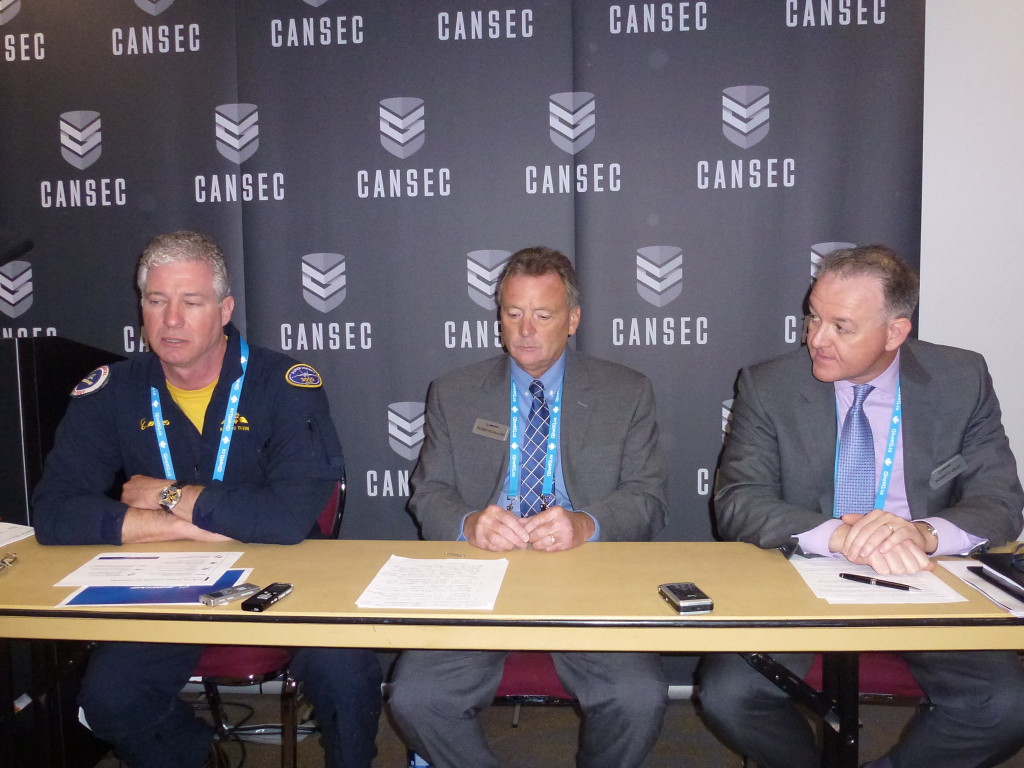
OTTAWA – On Thursday morning Boeing called a press conference for 10am in order to pitch its twin engine jet fighter F-18E/F Super Hornet.
The speakers to discuss about Super Hornet’s capabilities, program milestones, and potential markets were former Canadian Air Force CF-18 Hornet pilot and now Boeing F/A-18 Super Hornet chief test pilot Riccardo Traven; Roger Schallom, Manager, Canada Industrial Participation Program, Integrated Defense Systems; and Roberto Valla, Vice President Canada, Defense, Space & Security.
Canada selected the McDonnell Douglas F-18A/B Hornet twin jet fighter bomber in 1980 and deliveries of the 138 aircraft occured between 1982 and 1988.
The Boeing (né McDonnell Douglas) F/A-18E/F Super Hornet flew for the first time on November, the 29th, 1995.
Far more than being a beef-up F-18 Hornet, with its 11 weapons stations, the Super Hornet powered by two GE F414-GE-400 gives warfighters extraordinary payload flexibility by carrying more than 400 configurations of air-to-air and air-to-ground ordnance.
Through an evolutionary, modular approach, including the addition of the APG-79 active electronically scanned array radar, the Super Hornet offers continuously improving overall mission capability and supportability. Integrating the Raytheon APG-79 AESA radar, Advanced Targeting Forward Looking Infrared system, Joint Helmet Mounted Cueing System, Multifunctional Information Distribution System, advanced high capacity computer system, and state-of-the-art cockpit provides the warfighter with intuitive situational awareness and capability.
The first operational F/A-18E/F Super Hornet squadron formed in June 2001 and deployed into combat aboard the USS Abraham Lincoln (CVN 72) in July 2002. In April 2005, Boeing delivered the first Block II Super Hornet, complete with the world’s first tactical multi-mode AESA radar, and it became fully operational at the end of 2007.
Since inception, the Super Hornet program has remained on time and on cost. A total of 707 F-18E/F has been delivered on time or ahead of schedule.
The Royal Australian Air Force operates 24 F model Super Hornets.
In May 2015, Australia announced plans to acquire 12 new EA-18 Growlers, the airborne electronic attack derivative of the Super Hornet.
Ricardo Traven really wished to underline that in spite of the assertions of the people of Lockheed Martin, a single-engine Lockheed Martin F-35 Lightning II is unsuitable for long-range missions into regions such as the Arctic despite the improved reliability of modern turbines.
Mr. Traven who flew more than 200 types of aircraft took a totally different angle to prove the necessity of a twin engine combat aircraft.
He put forward his own experience when in his mid-20s, he flew from Goose Bay, Labrador to Europe for a North Atlantic Treaty Organization (NATO) exercise. In the middle of no where, he lost an engine as he was equidistant from his takeoff point and runways in Greenland and Iceland. Hopefully, flying a twin jet, Riccardo Traven managed to refuel without incident from an accompanying tanker and returned safely to Goose Bay.
Nevertheless, Mr. Traven acknowledged that there have been giant improvements in engines reliability but the possibility of foreign object damage (FOD) such as a bird strike or ice ingestion or a ruptured fuel line or a maintenance oversight or a bullet remains. It is not about ‘the reliability of the core of the engine…but everything else that makes the engine run’
Riccardo Traven was also asked about the ‘stealth’ issue, a key feature in Canada’s early decision in 1997 to be involved in the multinational Joint Strike Fighter development program which lead the Lockheed Martin F-35 Lightning II. The Boeing F-18 Super Hornet chief pilot dismissed the argument that the Super Hornet say that it is easier to detect with radar than the F-35.
The F-18 has one characteristic that very fighter jet has : being able to become a tanker for another aircraft. The F-18 Super Hornet like the F-18 Hornat can be equipped with a central tank and a hose to refuel in flight others F-18 or any other combat fitted with a ‘Hose and Drogue’system.
He affirmed that the ‘The Super Hornet is far stealthier than people know’ but he was unable to get into details, the information being classified.
Its folding wings improve ramp and hangar space and make the F-18E/F fits into NATO shelters.
In August 2013, Boeing and Northrop Grumman conducted flight tests with a prototype of an Advanced Super Hornet aircraft with conformal fuel tanks, an enclosed weapons pod and signature enhancements. These capabilities, along with other planned advanced technologies to include enhanced engines, internal infrared search and track, and a next-gen cockpit, offer domestic and international customers a menu of next-generation capabilities that will allow Super Hornets to outpace threats in the 2030+ threat environment.
According to him stealth was a key factor but Super Hornet’s radar, electronic countermeasures and its twin-engine configuration are key elements of the survibility of the aircraft and its crew.
Asked about the perenity of the F-18 assembly line in Saint-Louis, Missouri, the panel gave reassurance. Robert Schallom underlined that its current backlog takes deliveries into 2018. Kuwait and additional domestic Fiscal Year 2017 and Fiscal Year 2018 orders take deliveries into 2020. For him, this provides a bridge to future international opportunities like Canada. Boeing sees opportunities for more than 300 F-18 Super Hornet at home and around the world. actives campaigns are on in the United States, Canada, Belgium, Denmark, Finland, India, Kuwait and Spain.
Diplômé universitaire en histoire, journalisme et relations publiques, en 1993, Philippe Cauchi amorce une carrière de journalisme, analyste et consultant en aérospatiale. En 2013, il fonde avec Daniel Bordeleau, le site d’information aérospatial Info Aéro Québec.
Commentaires